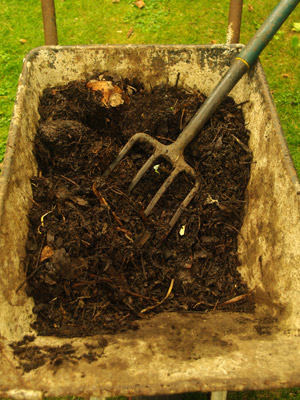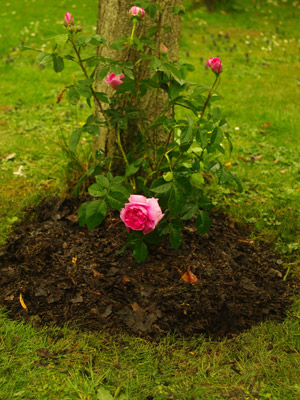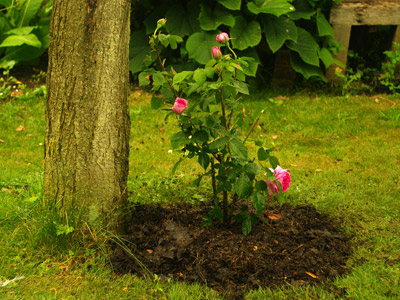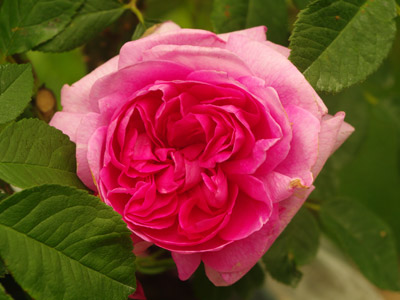 How
to Plant a Rose in Your Garden
How
to Plant a Rose in Your Garden
A rose bush can live for decades, half an hour spent at planting time will set your plant up to establish quickly and start rewarding you with flowers as soon as possible.
Like all shrubs, roses are best planted in the dormant season, don't worry if this isn't possible however, container plants can be planted any time of the year.
Newly planted roses take some time to get established, during this time they are vulnerable to competition from weeds, from drying out and are more susceptible to disease. They are much more likely to fail in the first year than afterwards, so it makes sense to spend a little extra time to make life easy for them until they have a chance to grow out strong new roots into the soil and are able to look after themselves.
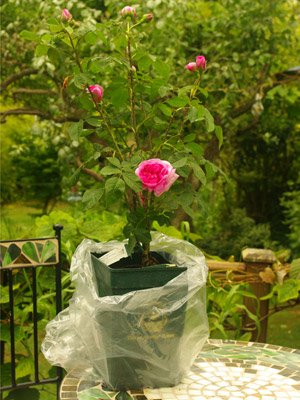
Buy your rose. This is s smallish climber (2.5m - 8ft) called Gertrude Jekyll it is repeat flowering with a wonderful strong old-rose scent, because if you're going to plant a rose you might as well plant one that is deliciously scented.
I always spend the time to choose a rose according to factors such as size, flowering season/s and scent as well as how much I like the flowers and then seek out the variety I want. Roses vary quite significantly in these parameters, so make sure you are getting what you expect and don't only go on what the flower looks like on the label.

Choose your planting position. Roses like the sun, and so should be planted somewhere they get sun for as much of the day as possible. They will struggle on in the shade and while they may even produce a flower or two, they are much, much better in the sun.
This is to be planted at the base of a recently deceased plum tree that we decided will be better supporting a climbing rose than if we just removed it, eventually the tree will fall at which point I'll put a decorative metal support for the rose.
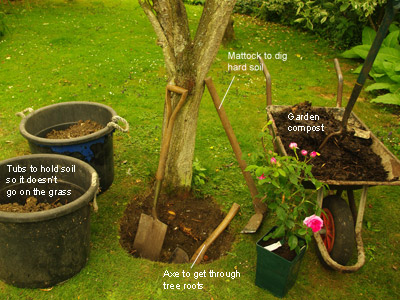
Assemble your tools. I'm going to add some well-rotted garden compost to get the rose off to the best possible start, see how much there is? About 4-5 x the volume of the pot the rose is in, don't skimp. If you don't have your own garden compost you can buy in some bulky organic matter, peat or similar.
Use something to put the soil in that you dig out of the hole so it doesn't make a mess on your lawn. A garden spade will probably be enough for digging, but I always like to have my mattock just in case the soil is hard, you don't have one? Get one, they're not expensive and are endlessly useful. Due to positioning here I also needed an axe for the tree roots I encountered.
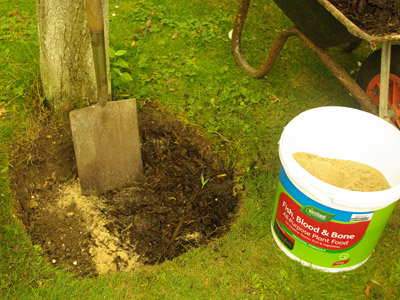
Begin planting. Clear a 60cm / 2ft dia area of grass and dig a hole. A pretty big hole, at least 4 times the volume of the root ball or pot your rose is in, use a big bucket or wheelbarrow to put the soil in to keep things clean. It'll be going back in again soon.
The hole should be a couple of inches deeper than the pot the rose is in, yes it will be an effort, yes it will be worth it.
When dug add a handful of slow release fertiliser to the bottom of the hole, mix it in lightly with the spade, this will help feed the rose when it gets established and prevent the grass from getting the nutrients first.

Plant the rose. The soil will be very soft now, make a hole with the spade, you'll just need to push it to the side more than dig. Put your left hand flat on the compost in the pot with your thumb one side of the stem and fingers on the other and turn the pot upside down, squeeze the sides gently to release the rose and compost and gently place the whole thing into the hole. There's no need to tease out any surface roots, it will sort itself out very quickly.

Firm down the soil. Gently with your foot, just standing on it, add the rest you took out of the hole, there will be a bit of a mound higher than the surrounding soil, don't worry about this but make sure the compost level in the pot is the same as the immediate soil level, it will all settle down to the former ground level.

Water the rose in very well. Use a whole watering can full, this will settle the soil and rose plant into their new positions.
As the rose was in full growth with flowers at this time, I added some soluable fertiliser to the water to help it on its way and help it get over the trauma of being transplanted, this is not necessary in the dormant season.
Water during dry spells over the remainder of the growing season. An occasional soak once every week or two is preferable to little and often as the latter can encourage shallow roots rather than deeper roots that go looking for water. It should be able to look after itself by the second year, though an occasional watering if the spring is dry will help, the area around it should be kept free of grass and weeds.
Copyright 2000 - present. All Rights Reserved | Privacy Policy Statement

